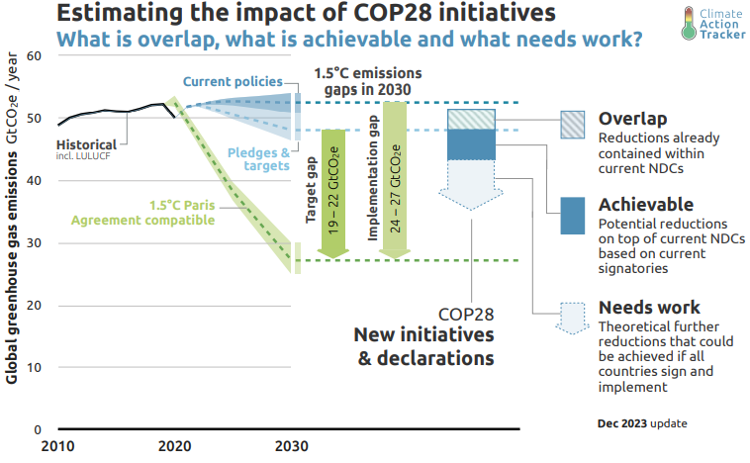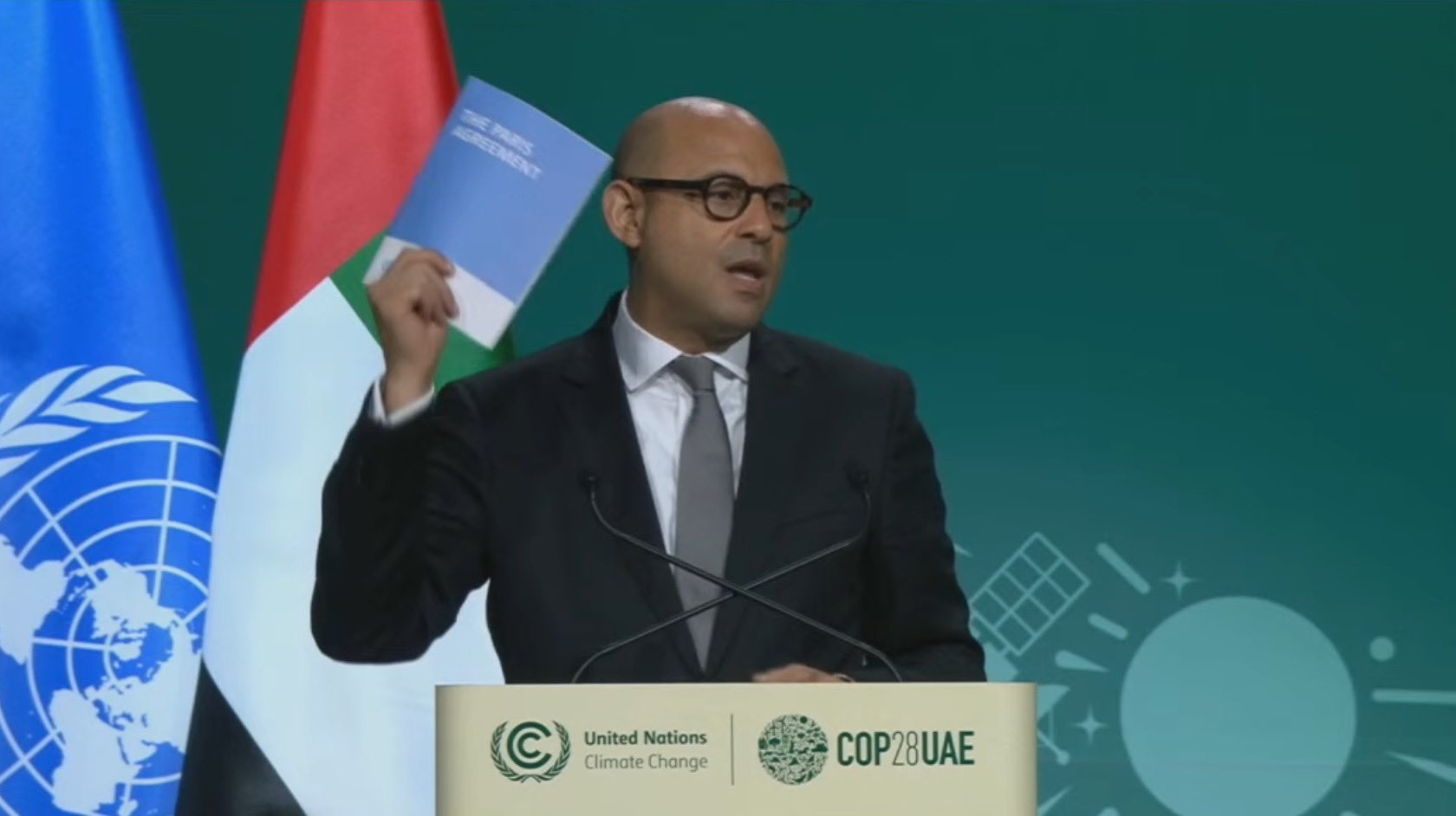Title image: Simon Stiell, Executive Secretary, UNCC speaking at COP28
COP28—A Qualified Success

COP28 President Dr. Al Jaber and UN Climate Change Executive Secretary, Simon Stiell, lead the conference closing session Image Credit: UNFCC
(Editor’s note: If you haven’t already, this would be a good time to read our pre-COP28 post. This post builds upon it.)
A Focus on 1.5ºC
Well, it’s been a month since the 28th Conference of the Parties wrapped up — plenty of time for the dust to settle, to assess the results, and to see if the climate outlook has improved.
After last year’s lackluster COP27, Dubai’s COP28 certainly succeeded in gaining the attention of governments and industry, setting a COP record of 85,000 participants, more than twice the previous record set by COP26 in Glasgow, Scotland.
As we discussed in our previous post, the 2023 UNEP Emissions Gap Report put fossil fuel emissions squarely in the spotlight for COP28, with dramatic reductions needed to meet the Paris Agreement goal of limiting climate warming to 1.5ºC. With much pre-conference talk of fossil fuel “phase-out” or “phase-down,” it’s not surprising that there was significant representation by the oil and gas industry, with over 2,400 fossil fuel representatives and lobbyists in attendance — a record.
Nonetheless, in an interview prior to COP28, Conference President Dr. Sultan Ahmed Al Jaber, CEO of the world’s 12th largest oil company, stated: “Getting back on track, and ensuring that the world accepts a robust understanding of a roadmap to 2030 that will keep 1.5ºC within reach is my only goal.”
That 1.5ºC goal was clearly front and center when Dr. Al Jaber laid out the high level goals for COP28:
- Tripling renewable energy capacity and doubling the rate of energy efficiency improvements across sectors by 2030, including ramping up electrification and enhanced cooling approaches, to enable phase-down of fossil fuels.
- More than halving oil and gas industry scope 1 and 2 emissions, including reaching near-zero methane emissions by 2030.
- Transforming heavy-emitting sectors, including scaling up use of low-carbon hydrogen, carbon capture and storage, and carbon dioxide removal, aligned with science.
- Substantially shifting toward fossil-free forms of transport, including through vehicle electrification and modal shifts.
- Taking action to accelerate efforts towards the phase-down of unabated coal power and phase-out of inefficient fossil fuel subsidies, addressing coal-related methane emissions and deploying clean baseload capacity.
- Companies and countries set ambitious goals, take action, and remain accountable through disclosures, in line with best practices and global standards.
While the conference results did not fully meet the goals, they came encouragingly close. Comprehensive records of the conference results are available from UN Climate Change (set aside a lot of time and start here). For an independent perspective, check here.
The conference addressed a broad range of climate-related issues. In this article, we’re looking at COP28 efforts to meet the 1.5ºC goal.
The COP Process
Before we discuss the outcomes of the conference, it’s worth a moment to examine the COP28 decision-making process. In the case of the Paris Agreement and subsequent UN climate negotiations, decisions are taken by consensus, without a formal vote. Within the UN system, consensus “is understood as the absence of objection rather than a particular majority.” In a scenario like COP28, consensus is reached when all Member States agree on a document, but that does not mean that they all agree on every element of the draft text, only that no one objects.
Prior to, and during COP28, negotiators from nearly 200 Parties debated draft language that would unequivocally keep the global temperature goal of 1.5ºC within reach. Achieving that goal would require a full “phase-out” of oil, gas and coal—a path ultimately leading to the net elimination of fossil fuel emissions by 2050.
Given that the conference was hosted by a petrostate, presided over by the CEO of an oil and gas company, and attended by a phalanx of fossil fuel industry representatives, we shouldn’t be surprised that the final “consensus” text is considerably less aggressive.
Nevertheless, the final COP28 text is a historic milestone. Incredibly, this is the first COP text in 28 years of debate and negotiation to even mention fossil fuels. But it went far beyond that.
“Beginning of the End” for Fossil Fuels
Whilst we didn’t turn the page on the fossil fuel era in Dubai, this outcome is the beginning of the end
Simon Stiell, Executive Secretary, UN Climate Change
Yes, at the close of COP28 the conference’s senior UNCC representative really signaled the end of fossil fuels.
The official COP28 decisions text is available on the UN Climate Change website. Here is the excerpt relevant to this article:
[excerpt begins]
The Conference of the Parties serving as the meeting of the Parties to the Paris
Agreement,….
27. Also recognizes that limiting global warming to 1.5 °C with no or limited overshoot requires deep, rapid and sustained reductions in global greenhouse gas emissions of 43 per cent by 2030 and 60 per cent by 2035 relative to the 2019 level and reaching net zero carbon dioxide emissions by 2050;
28. Further recognizes the need for deep, rapid and sustained reductions in greenhouse gas emissions in line with 1.5 °C pathways and calls on Parties to contribute to the following global efforts, in a nationally determined manner, taking into account the Paris Agreement and their different national circumstances, pathways and approaches:
(a) Tripling renewable energy capacity globally and doubling the global average annual rate of energy efficiency improvements by 2030;
(b) Accelerating efforts towards the phase-down of unabated coal power;
(c) Accelerating efforts globally towards net zero emission energy systems, utilizing zero- and low-carbon fuels well before or by around mid-century;
(d) Transitioning away from fossil fuels in energy systems, in a just, orderly and equitable manner, accelerating action in this critical decade, so as to achieve net zero by 2050 in keeping with the science;
(e) Accelerating zero- and low-emission technologies, including, inter alia, renewables, nuclear, abatement and removal technologies such as carbon capture and utilization and storage, particularly in hard-to-abate sectors, and low-carbon hydrogen production;
(f) Accelerating and substantially reducing non-carbon-dioxide emissions globally, including in particular methane emissions by 2030;
(g) Accelerating the reduction of emissions from road transport on a range of pathways, including through development of infrastructure and rapid deployment of zero and low-emission vehicles;
(h) Phasing out inefficient fossil fuel subsidies that do not address energy poverty or just transitions, as soon as possible;
[excerpt ends]
Paragraph 28(d) is the headline grabber that encouraged Stiell to forecast the end of fossil fuels. However, neither 28(d) nor any of the other agreements in section 28 are binding in any way, and there are many loopholes that can allow countries to soften their commitments. The key in section 28 is “calls on” — UNFCCC-speak for the weakest form of an “invitation” or “request.” Still, it is perhaps the best COP result we could expect.
Binding or not, the COP28 text does address Dr. Al Jaber’s most critical COP28 goals—a big step in the right direction. Perhaps more important than the final agreement text are the “Pledges and Declarations” and
“New Initiatives” announced as part of COP28. The most significant of these is the pledge to triple renewable energy capacity and double energy efficiency (paragraph 28(a) in the decision text excerpt above.)
But is the sum of COP28 initiatives, pledges and commitments big enough to support the 1.5C goal?
We’re Not There Yet…
As the COP28 text notes, holding climate warming to 1.5C requires reducing global greenhouse gas emissions by 43 per cent by 2030 and 60 per cent by 2035. These aggressive milestones are not arbitrary. Rather, they reflect our diminishing carbon budget—the cumulative amount of carbon dioxide equivalent emissions permitted to keep within a certain temperature limit.
The global rate of greenhouse gas (GHG) emissions by 2030, given current national climate policies, will amount to the equivalent of 52.5 Gigatonnes of CO2 per year—or 52.5 GtCO2e/year. If we add in additional pledges and stated targets, the rate of GHG emissions falls to 47.5 GtCO2e. In order to meet the 1.5C goal, the rate of GHG emissions in 2030 needs to be 27 GtCO2e/year, or less.
These are big numbers! A Gigatonne is one billion metric tons, or 2.2 trillion pounds, or 10,000 fully loaded US aircraft carriers. So global 2030 emissions of 52.5 Gt/year is equivalent to 525,000 carriers/year. (The US has a total of 11 active aircraft carriers.)
Climate Action Tracker has published an thorough review of the initiatives and pledges agreed to at COP28, in the context of pathways to limiting climate warming to 1.5C. The following chart is a high level view, showing the “Implementation Gap,” the shortfall in 2030 between the result of current government policies and the 27 GtCO2e/year goal. Add in the various Pledges and Targets (i.e., promises) and you reduce the shortfall to the Target Gap.

The COP28 new initiatives and announcements are shown in the blue arrow, showing where we might end up in 2030 if these initiatives are carried out. Some initiatives overlap existing Nationally Determined Contributions (NDCs) for no net gain – the “Overlap” segment of the arrow.
The “Achievable” segment represents new initiatives – limited by the number of countries that signed up. The initiative to triple renewable energy capacity, for example.
The “Needs Work” segment projects the impact if all countries signed-on to each of the initiatives. (Currently there are major countries missing, notably China, which hasn’t committed to “doubling energy efficiency” although it is likely to triple renewable energy without difficulty.)
COP29 and COP30
The next two years will be critical. At COP29, governments must establish a new climate finance goal, in keeping with the scale and urgency of the 1.5C goal. And at COP30, the Parties are required to commit to new nationally determined contributions that are economy-wide, cover all greenhouse gases and are fully aligned with the 1.5°C temperature limit.
At COP28 the Parties designated Azerbaijan (another petrostate!) as host of COP29 in November 2024, and Brazil as COP30 host in November 2025.
“We must get on with the job of putting the Paris Agreement fully to work,” said UNCC Executive Secretary Simon Stiell in his closing speech at COP28. “In early 2025, countries must deliver new nationally determined contributions. Every single commitment – on finance, adaptation, and mitigation – must bring us in line with a 1.5-degree world.”

